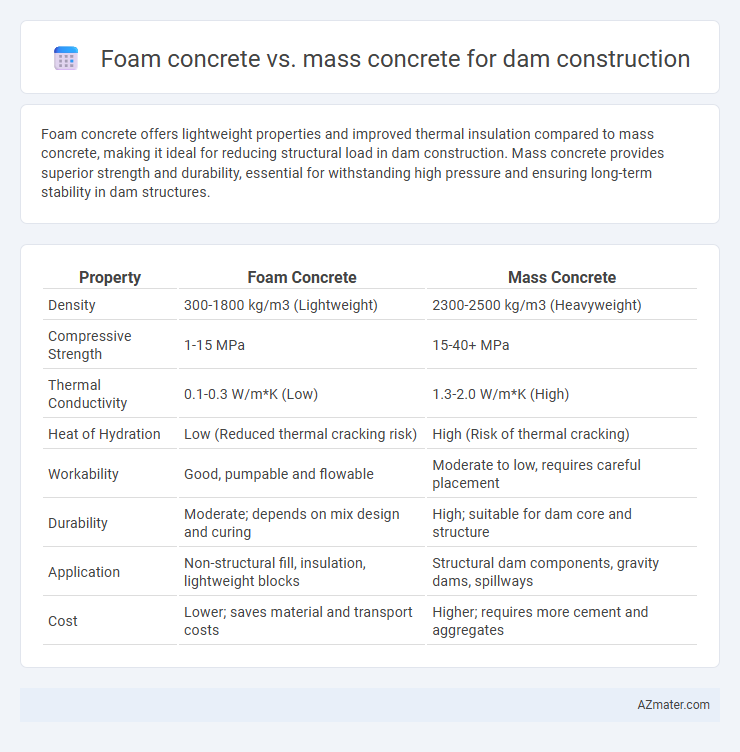Foam concrete offers lightweight properties and improved thermal insulation compared to mass concrete, making it ideal for reducing structural load in dam construction. Mass concrete provides superior strength and durability, essential for withstanding high pressure and ensuring long-term stability in dam structures.
Table of Comparison
| Property | Foam Concrete | Mass Concrete |
|---|---|---|
| Density | 300-1800 kg/m3 (Lightweight) | 2300-2500 kg/m3 (Heavyweight) |
| Compressive Strength | 1-15 MPa | 15-40+ MPa |
| Thermal Conductivity | 0.1-0.3 W/m*K (Low) | 1.3-2.0 W/m*K (High) |
| Heat of Hydration | Low (Reduced thermal cracking risk) | High (Risk of thermal cracking) |
| Workability | Good, pumpable and flowable | Moderate to low, requires careful placement |
| Durability | Moderate; depends on mix design and curing | High; suitable for dam core and structure |
| Application | Non-structural fill, insulation, lightweight blocks | Structural dam components, gravity dams, spillways |
| Cost | Lower; saves material and transport costs | Higher; requires more cement and aggregates |
Introduction to Dam Construction Materials
Foam concrete and mass concrete are fundamental materials in dam construction, with foam concrete offering lightweight, high thermal insulation, and reduced shrinkage properties compared to traditional mass concrete. Mass concrete provides superior compressive strength and durability, essential for the structural integrity of large dams. Selecting between these materials depends on specific project demands, including load-bearing requirements, thermal stress management, and overall construction efficiency.
Overview of Foam Concrete
Foam concrete is a lightweight, aerated material created by mixing cement, water, and pre-formed foam, offering high thermal insulation and reduced dead weight compared to traditional materials. Its low density, typically ranging from 400 to 1600 kg/m3, makes it ideal for reducing structural loads in dam construction while maintaining sufficient compressive strength and durability. Foam concrete also provides excellent flowability and self-compacting properties, enabling efficient placement and improved bonding with mass concrete sections in dam projects.
Overview of Mass Concrete
Mass concrete is a critical material in dam construction characterized by its large volume and low heat of hydration, ensuring structural stability and durability in massive placements. It typically consists of conventional concrete mixes with controlled temperature and placement techniques to prevent thermal cracking during curing. The emphasis on thermal control, strength, and durability makes mass concrete suitable for gravity and arch dam foundations where long-term performance is essential.
Key Material Properties Comparison
Foam concrete offers significantly lower density ranging from 400 to 1600 kg/m3 compared to mass concrete's typical density of 2400 kg/m3, enhancing thermal insulation and reducing self-weight in dam structures. Foam concrete exhibits superior thermal conductivity between 0.1 to 0.3 W/m*K, minimizing thermal cracking risks during curing, while mass concrete has higher thermal conductivity around 1.7 W/m*K, requiring careful thermal control measures. Compressive strength of foam concrete varies widely from 1 MPa to 17 MPa, suitable for lightweight applications, whereas mass concrete consistently provides higher compressive strength values of 20 to 40 MPa, essential for structural stability in dam construction.
Thermal Performance: Foam vs Mass Concrete
Foam concrete offers superior thermal insulation compared to mass concrete due to its porous structure, reducing heat generation and minimizing thermal cracking risks in dam construction. Mass concrete, characterized by its high density and low porosity, experiences significant heat of hydration, necessitating cooling measures to control temperature differentials and prevent structural damage. Optimizing thermal performance in dam projects requires selecting foam concrete for insulation benefits or implementing cooling techniques with mass concrete to manage thermal stresses effectively.
Structural Strength and Durability Analysis
Foam concrete offers reduced density and improved thermal insulation compared to mass concrete, making it less suitable for high structural strength demands in dam construction. Mass concrete provides superior compressive strength and durability, essential for withstanding hydraulic and environmental loads over the dam's lifespan. Durability analysis shows mass concrete performs better in resisting cracking, chemical attack, and freeze-thaw cycles, crucial for long-term dam stability.
Workability and Construction Techniques
Foam concrete offers superior workability compared to mass concrete due to its lightweight, flowable consistency that allows for easier placement and reduced compaction effort in dam construction. Construction techniques with foam concrete involve pumping or pouring with minimal vibration, enhancing speed and reducing labor, whereas mass concrete requires careful layering, extensive compaction, and heat management to prevent thermal cracking. The reduced density and thermal conductivity of foam concrete enable faster curing and diminished thermal stress, making it advantageous for complex dam geometries and large placements.
Environmental Impact and Sustainability
Foam concrete offers superior environmental benefits over mass concrete in dam construction due to its lower density, reduced cement consumption, and enhanced insulation properties, leading to decreased carbon footprint and energy use. The lightweight nature of foam concrete minimizes the demand for raw materials and reduces transportation emissions, making it a sustainable alternative for large-scale infrastructure. Mass concrete, while robust, typically results in higher CO2 emissions and greater resource depletion, posing challenges to long-term environmental sustainability in dam projects.
Cost-Efficiency Assessment
Foam concrete offers significant cost-efficiency advantages over mass concrete in dam construction due to its lightweight properties, which reduce formwork and foundation requirements. The lower density of foam concrete decreases transportation and handling costs, while its insulating characteristics minimize thermal cracking and associated repair expenses. Mass concrete, although structurally robust, incurs higher costs from extensive curing and thermal control measures necessary to prevent cracking in large volumes.
Applications and Suitability in Dam Projects
Foam concrete offers lightweight properties and excellent thermal insulation, making it suitable for non-structural zones and backfill areas in dam projects where reduced load on foundations is critical. Mass concrete is preferred for main dam structures due to its high compressive strength, durability, and stability under immense hydrostatic pressure. Choosing between foam concrete and mass concrete depends on project-specific factors such as required strength, thermal management, and foundation bearing capacity.

Infographic: Foam concrete vs Mass concrete for Dam construction
 azmater.com
azmater.com